Defining a Topography
It is not necessary to define a topography to model in Leapfrog Energy, but a defined topography can be used as an upper boundary for all models built in the project. Here, for example, the topography is used as the upper boundary for a geological model; the model’s boundary is shown in dark grey and the topography, which is linked to the model’s boundary, is the transparent yellow. The geological model’s extents object, the red box in the scene below, shows the full height of the model as a whole; the topography effectively cuts away the parts of the model that occur above the topography.
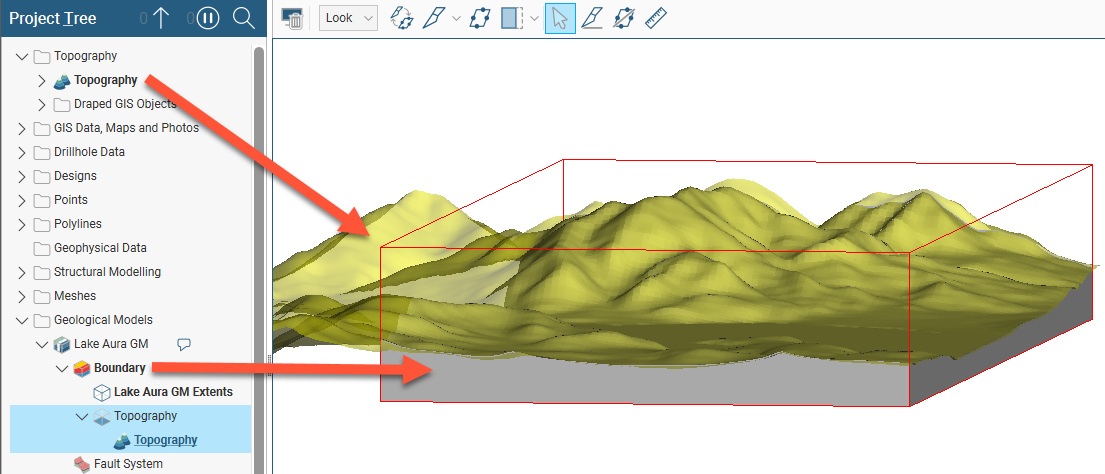
A key advantage of defining a topography is that it provides consistent elevation data for objects imported to and created in the project. The quality of elevation information can be poor compared to X- and Y-coordinates, which can create problems when using objects to build a model. A topography can be created from the most reliable elevation data, and other objects can have elevation set from this topography.
The topography can be created from an imported elevation grid, points data, surfaces and GIS data. It is not necessary to decide on a single source of information, as information can be combined, and you can add and remove data as required.
This topic describes creating and working with a topography. It is divided into:
- Creating a Topography
- Adding Height Data to the Topography
- Changing Topography Settings
- Draping Data Objects on the Topography
- Topography Display Options
- Custom Topography Views
- Exporting the Topography
Creating a Topography
The topography can be created from an imported elevation grid, points data, surfaces and GIS data. You can also set a fixed elevation, if you do not have any data suitable for creating a topography. Once the topography has been defined, additional height data can be added by right-clicking on the topography and selecting from the options available. See Adding Height Data to the Topography for more information.
An important consideration when defining the topography is ensuring that it is large enough to encompass the models you will be building in the project. If you create a small topography but then later create a model that extends outside the topography, you will need to enlarge the topography, which can result in considerable reprocessing of all objects in the project that use the topography as a boundary. See Extending a Surface for more information.
Topography From Elevation Grid
There are two ways to create the topography from an elevation grid:
- Right-click on the Topographies folder and select New Topography > Import Elevation Grid. Import the grid as described in Importing an Elevation Grid.
- Import the grid using the Meshes folder and then right-click on the Topographies folder and select New Topography > From Surface.
Enter a name for the topography and click OK. A hyperlink to the elevation grid will appear in the Topographies folder under the defined topography.
Topography From Surfaces, Points or GIS Vector Data
To create the topography from a surface, points or GIS data, first import the data into the project.
- Import surfaces into the Meshes folder.
- Import drilling data into the project or points data into the Points folder.
- Import GIS vector data into the GIS Data, Maps and Photos folder.
Next, right-click on the Topographies folder and select one of the New Topography options. A list of suitable objects available in the project will be displayed. Select the required object and click OK. Enter a name for the topography and click OK. A hyperlink to the source object will appear in the Topographies folder under the defined topography.
See also Changing Topography Settings below.
Fixed Elevation Topography
If you don’t have any data suitable for creating a topography, you can set a fixed elevation. To do this, right-click on the Topographies folder and select New Topography > Fixed Elevation. In the window that appears, enter a value for the elevation and click OK. Enter a name for the new topography and click OK.
The new topography will appear in the project tree under the Topographies folder.
Once a topography has been defined, the only way to set a fixed elevation is to remove the objects that have been used to define the topography. To do this, right-click on the hyperlinked object and click Remove. You will then be able to set a fixed elevation for the topography.
Adding Height Data to the Topography
When creating the topography, it is not necessary to decide on a single source of information, as information can be combined. Once the topography has been defined, additional height data can be added by right-clicking on the topography and selecting from the options available:
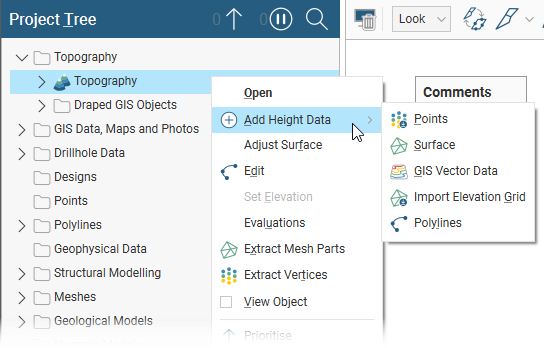
It is not possible to add structural data or polylines with orientation information to the topography. If you edit the topography with a polyline, your options for editing the polyline will be limited.
For points, surfaces and GIS vector data, you will be prompted to select from the data sources available in the project. For an elevation grid, see Importing an Elevation Grid.
All data objects used to define the topography will appear under the topography, hyperlinked to their parent objects:
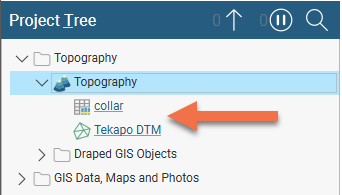
When you have added data to the topography, you may need to enlarge the topography extents. See Changing Topography Settings below.
To remove data objects from the topography, either:
- Delete the object from the topography. To do this, right-click on the hyperlinked object and click Remove.
- Delete the object from the project. If you choose this option, consider carefully the effects on other objects in the project, as once an object is deleted, it cannot be recovered.
When the topography is defined from multiple objects, you can set the resolution of the topography by double-clicking on it. See Changing Topography Settings below.
Changing Topography Settings
When the topography is created from points or GIS data or when the topography is created by combining data, you can change its boundary and resolution and apply a trend. To do this, double-click on the topography in the project tree. The Edit Topography window will appear:
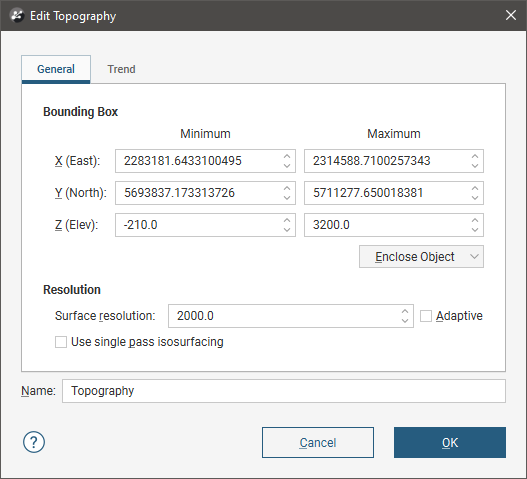
Changing the Size of the Topography
In the General tab, you can change the topography extents. Use the controls in the scene or enter the required values in the Bounding Box fields.
Topography Resolution
The resolution of the topography depends on how it was created.
- When the topography is created from a single mesh, the resolution of the topography is set from the resolution of the mesh and can only be changed when the mesh is imported. If you wish to change the resolution of the topography, you must first add more height data to the topography. See Adding Height Data to the Topography.
- When the topography is created by setting a fixed elevation, the resolution cannot be set.
When the topography is created from points or GIS data or when the topography is created from combining data, you can set its resolution in the Edit Topography window.
When you set a specific Surface resolution without enabling the Adaptive option, the triangles used will be the same size for the whole topography. When you enable the Adaptive option, the resolution of the topography will be affected by the availability and density of real data. See Adaptive Isosurfacing in the Surface Resolution in Leapfrog Energy topic for more information on this option.
Leapfrog Energy uses single pass isosurfacing by default as the accuracy of the mesh is typically adequate with a single pass. Double-pass mesh generation can result in higher accuracy in some situations, but there are tradeoffs. See Single Pass Isosurfacing in the Surface Resolution in Leapfrog Energy topic for more information on this option.
Applying a Trend to the Topography
In the Trend tab, you can apply a trend to the topography.
See Global Trends in the Trends and Anisotropy topic for more information.
Draping Data Objects on the Topography
Once you have defined a topography, you can drape GIS data objects and images imported into the GIS Data, Maps and Photos folder and contour lines in the Sections, Plans and Contours folder onto the topography.
To drape a data object onto the topography, right-click on the object in the project tree and enable the On Topography option:

The On Topography option will not appear in the right-click menu if there is no topography defined.
All draped objects will be listed in the Draped GIS Objects folder, under the topography:
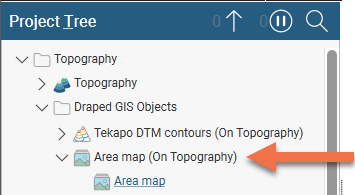
When you have draped objects on the topography and are using those objects in building models, you can sometimes choose whether to use the draped object or the object itself. For example, here in creating a lateral extent for a geological model using the north_boundary GIS object, you can choose whether to use the draped object or the undraped object:

Note that only the southwest_boundary GIS line can be used as it has not been draped on the topography.
To remove an object from the topography, right-click on either the draped object or the object itself and disable the On Topography option:

The object will be removed from the Draped GIS Objects folder and from objects that use the draped object.
The View Relationships option is not available for draped GIS objects and so Leapfrog Energy will not warn you before dependent objects are deleted. Before removing an object from the topography, be sure it is not being used elsewhere in the project:
- In custom topography views
- As an input to model objects such as faults and extents
- As the basis for meshes
You can select multiple objects and drape/remove them all at once:
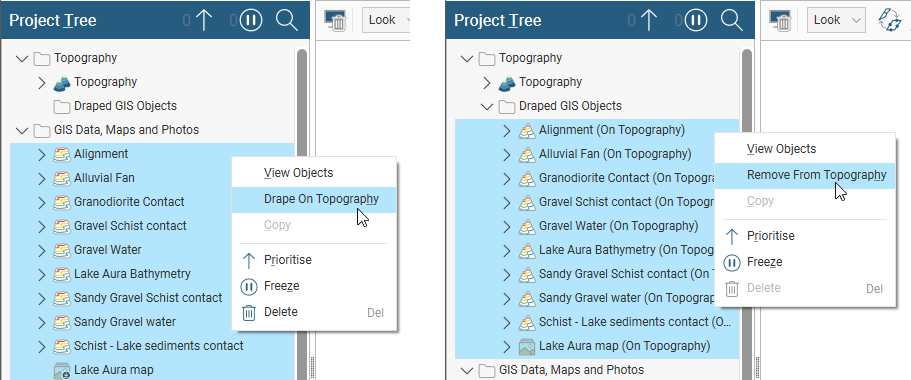
Topography Display Options
To display the topography in the scene window, either:
- Right-click on the topography in the project tree and select View Object.
- Click on the topography object and drag it into the scene.
The topography will be displayed in the scene window and in the shape list:
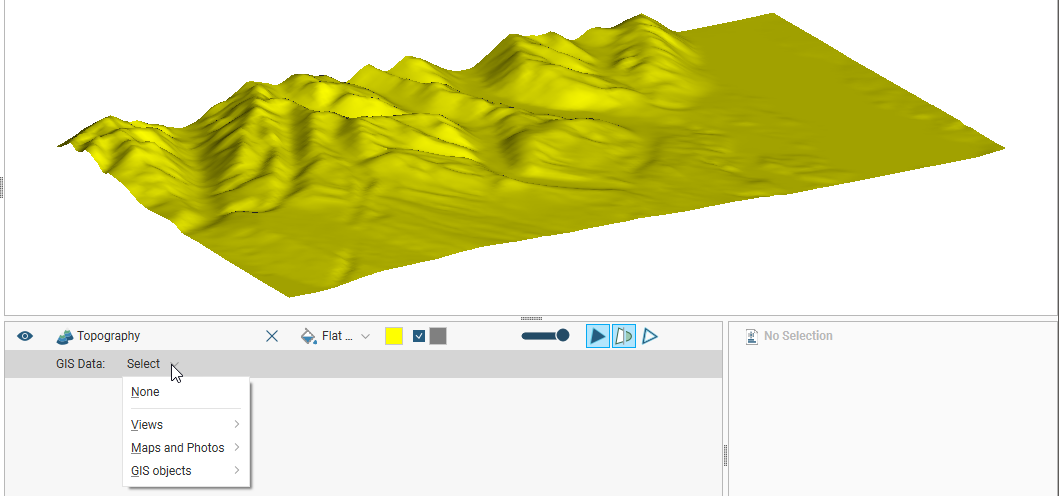
The topography object in the shape list provides additional controls that can be used to change the way the topography is displayed and highlight features of interest. For example, selecting an imported map from the list results in it being displayed draped onto the topography:

Note that only objects that have been draped on the topography are available from the GIS Data list. See Draping Data Objects on the Topography above for more information.
The list is organised into:
- Views. This contains options for creating and editing custom topography views and also lists any views already defined. With custom topography views, you can view multiple GIS objects, maps and contours. See Custom Topography Views below for more information.
- Maps and Photos. This lists all images stored in the GIS Data, Maps and Photos folder that have been draped on the topography.
- GIS objects. This lists all GIS data objects stored in the GIS Data, Maps and Photos folder that have been draped on the topography.
Custom Topography Views
In Leapfrog Energy, a topography can be displayed with any of the GIS data, images and contour lines in the project that have been draped on the topography.
Note that only objects that have been draped on the topography can be added to custom topography views. See Draping Data Objects on the Topography above for more information.
To create a custom view, add the topography object to the scene. Select Views > Edit views from the GIS data list:

The Edit GIS Views window will appear. Click New to create a new view. Enter a name for the new view and click Create:
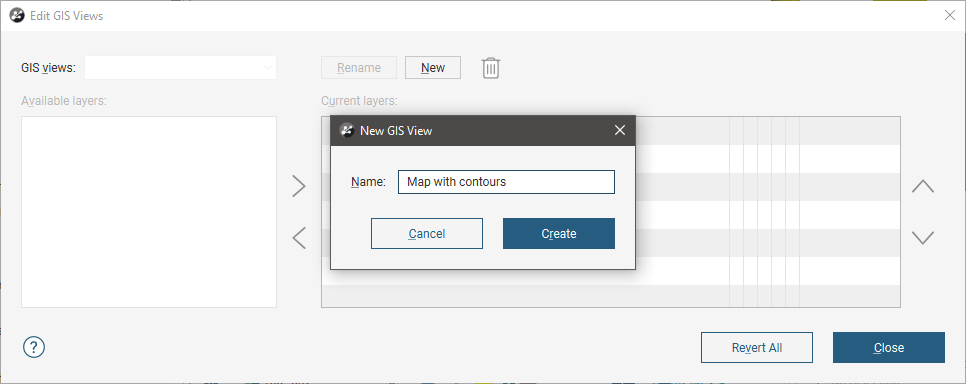
The new view will be created in the Edit GIS Views window, together with a list of Available layers. Use the arrows to move layers into the Current layers list and organise them:
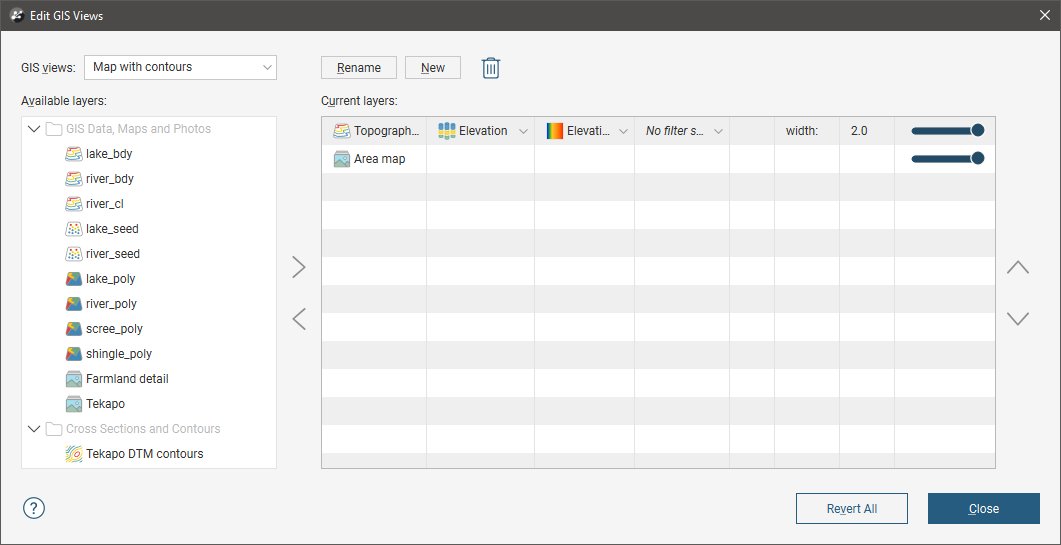
If you have defined a query filter for an object, you can use that filter in the custom view:
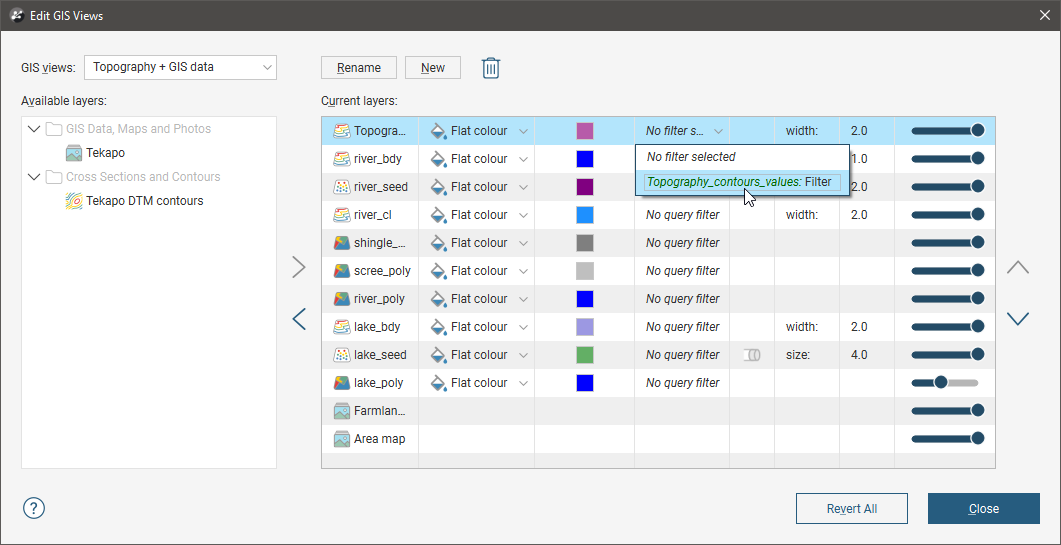
Use the transparency and point and line size controls to emphasise data.
Click Close. The topography will be displayed in the scene with the new view applied:
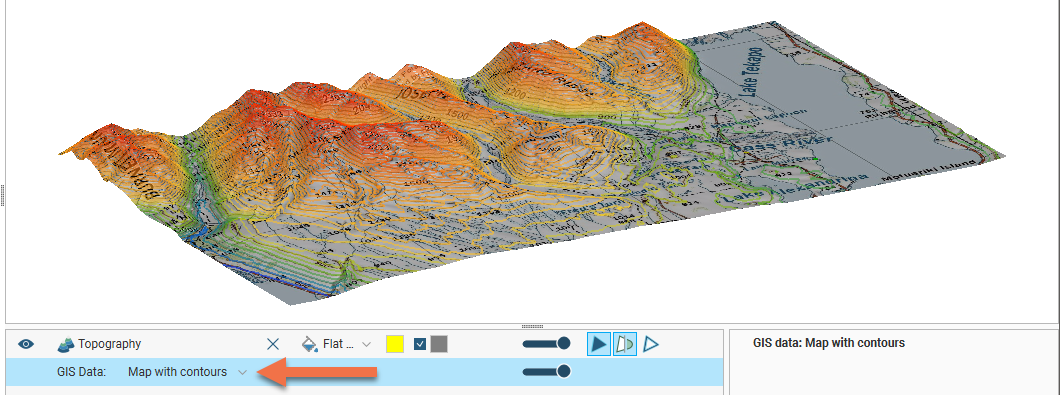
Exporting the Topography
Once defined, you can export the topography as a mesh or as an elevation grid. See:
Got a question? Visit the Seequent forums or Seequent support
© 2023 Seequent, The Bentley Subsurface Company
